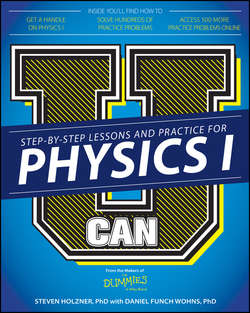Читать книгу U Can: Physics I For Dummies - Steven Holzner - Страница 6
На сайте Литреса книга снята с продажи.
Part I
Chapter 1
Using Physics to Understand Your World
Observing Objects in Motion
ОглавлениеSome of the most fundamental questions you may have about the world deal with objects in motion. Will that boulder rolling toward you slow down? How fast do you have to move to get out of its way? (Hang on just a moment while we get out our calculator… .) Motion was one of the earliest explorations of physics.
When you take a look around, you see that the motion of objects changes all the time. You see a motorcycle coming to a halt at a stop sign. You see a leaf falling and then stopping when it hits the ground, only to be picked up again by the wind. You see a pool ball hitting other balls in just the wrong way so that they all move without going where they should. Part I of this book handles objects in motion – from balls to railroad cars and most objects in between. In this section, we introduce motion in a straight line and rotational motion.
Measuring speed, direction, velocity, and acceleration
Speeds are big with physicists – how fast is an object going? Thirty-five miles per hour not enough? How about 3,500? No problem when you’re dealing with physics. Besides speed, the direction an object is going is important if you want to describe its motion. If the home team is carrying a football down the field, you want to make sure they’re going in the right direction.
When you put speed and direction together, you get a vector – the velocity vector. Vectors are a very useful kind of quantity. Anything that has both size and direction is best described with a vector. Vectors are often represented as arrows, where the length of the arrow tells you the magnitude (size), and the direction of the arrow tells you the direction. For a velocity vector, the length corresponds to the speed of the object, and the arrow points in the direction the object is moving. (To find out how to use vectors, head to Chapter 4.)
Everything has a velocity, so velocity is great for describing the world around you. Even if an object is at rest with respect to the ground, it’s still on the Earth, which itself has a velocity. (And if everything has a velocity, it’s no wonder physicists keep getting grant money – somebody has to measure all that motion.)
If you’ve ever ridden in a car, you know that velocity isn’t the end of the story. Cars don’t start off at 60 miles per hour; they have to accelerate until they get to that speed. Like velocity, acceleration has not only a magnitude but also a direction, so acceleration is a vector in physics as well. We cover speed, velocity, and acceleration in Chapter 3.
Round and round: Rotational motion
Plenty of things go round and round in the everyday world – CDs, DVDs, tires, pitchers’ arms, clothes in a dryer, roller coasters doing the loop, or just little kids spinning from joy in their first snowstorm. That being the case, physicists want to get in on the action with measurements. Just as you can have a car moving and accelerating in a straight line, its tires can rotate and accelerate in a circle.
Going from the linear world to the rotational world turns out to be easy, because there’s a handy physics analog (which is a fancy word for “equivalent”) for everything linear in the rotational world. For example, distance traveled becomes angle turned. Speed in meters per second becomes angular speed in angle turned per second. Even linear acceleration becomes rotational acceleration.
So when you know linear motion, rotational motion just falls in your lap. You use the same equations for both linear and angular motion – just different symbols with slightly different meanings (angle replaces distance, for example). You’ll be looping the loop in no time. Chapter 7 has the details.
